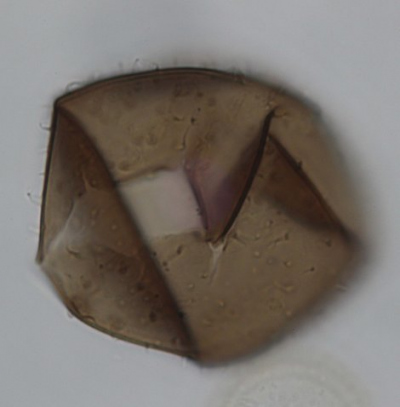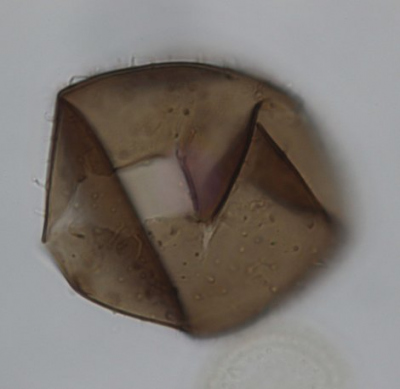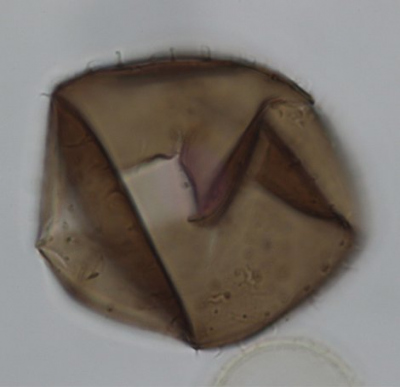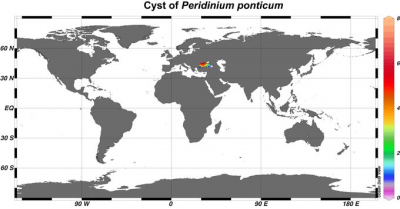Die Inhalte dieser Seite sind leider nicht auf Deutsch verfügbar.
Seitenpfad:
Peridinium ponticum
Zonneveld, K.A.F. and Pospelova V. (2015). A determination key for modern dinoflagellate cysts. Palynology 39 (3), 387- 407.



dorsal view
Sample: GeoB 7609-1, 2.5 cm
Black Sea, subsurface
photograph: Karin Zonneveld
Sample: GeoB 7609-1, 2.5 cm
Black Sea, subsurface
photograph: Karin Zonneveld
dorsal view 2
cross section
Field characteristics
Peridinium ponticum Wall and Dale in Wall et al., 1973
Field characteristics:
Subspherical to pentagonal brown cyst covered with two types of ornaments. The first type are small, delicate, curved or straight, transparant simple spines, The second type are submicron-sized tubercules (micrograna). These are densely distributed over the entire cyst but can be less frequent in the equatorial region. The shape can vary from subspherical to dorso-ventrally compressed pentagonal. The archeopyle is hexagonal and formed by the loss of an intercalary paraplate.
Dimensions: 43 - 59 µm length, 43 - 56 µm width.
Comparison with other species:
This species is easily distinguished from all other species by it‘s two types of processes in case it has a pentagonal shape. When subspherical it can be distinguished from Echinidinium species in having a intercalary archeopyle. It differs clearly from Protoperidinium monospinum in having no branched processes.
Field characteristics:
Subspherical to pentagonal brown cyst covered with two types of ornaments. The first type are small, delicate, curved or straight, transparant simple spines, The second type are submicron-sized tubercules (micrograna). These are densely distributed over the entire cyst but can be less frequent in the equatorial region. The shape can vary from subspherical to dorso-ventrally compressed pentagonal. The archeopyle is hexagonal and formed by the loss of an intercalary paraplate.
Dimensions: 43 - 59 µm length, 43 - 56 µm width.
Comparison with other species:
This species is easily distinguished from all other species by it‘s two types of processes in case it has a pentagonal shape. When subspherical it can be distinguished from Echinidinium species in having a intercalary archeopyle. It differs clearly from Protoperidinium monospinum in having no branched processes.
Geographic distribution
Geographic distribution based on :
Zonneveld et al., 2013. Atlas of modern dinoflagellate cyst distribution based on 2405 datapoints. Review of Palaeobotany and Palynology, v. 191, 1-197
Zonneveld et al., 2013. Atlas of modern dinoflagellate cyst distribution based on 2405 datapoints. Review of Palaeobotany and Palynology, v. 191, 1-197
Peridinium ponticum is endemic to the brackish Black Sea and Marmara Sea.

Distribution:
The distribution of Peridinium ponticum is restricted to the Black Sea and Marmara Sea. Here it can form up to 7% of the association. It is restricted to brackish environments.
Environmental parameters:
SST: 7.1 - 23.2°C (winter - summer), iSSS: 17.5 - 26.0 (summer - winter), [P]: 0.22 - 0.33 μmol/l, [N]: 0.59 - 0.83 μmol/l, chlorophyll-a: 0.61 - 4.16 ml/l, bottom water [O2]: 0.8 - 2.4 ml/l.
The distribution of Peridinium ponticum is restricted to brackish water environments with mesotrophic to eutrophic upper waters conditions.
Comparison with other records:
Peridinium ponticum has not been recorded from regions not covered by this Atlas.
The distribution of Peridinium ponticum is restricted to the Black Sea and Marmara Sea. Here it can form up to 7% of the association. It is restricted to brackish environments.
Environmental parameters:
SST: 7.1 - 23.2°C (winter - summer), iSSS: 17.5 - 26.0 (summer - winter), [P]: 0.22 - 0.33 μmol/l, [N]: 0.59 - 0.83 μmol/l, chlorophyll-a: 0.61 - 4.16 ml/l, bottom water [O2]: 0.8 - 2.4 ml/l.
The distribution of Peridinium ponticum is restricted to brackish water environments with mesotrophic to eutrophic upper waters conditions.
Comparison with other records:
Peridinium ponticum has not been recorded from regions not covered by this Atlas.


